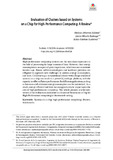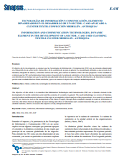Memberships Networks for High-Dimensional Fuzzy Clustering Visualization

Compartir este ítem
Autor
Ariza-Jiménez L.
Villa L.F.
Quintero O.L.
Citación
Metadatos
Mostrar el registro completo del ítemResumen
Visualizing the cluster structure of high-dimensional data is a non-trivial task that must be able to deal with the large dimensionality of the input data. Unlike hard clustering structures, visualization of fuzzy clusterings is not as straightforward because soft clustering algorithms yield more complex clustering structures. Here is introduced the concept of membership networks, an undirected weighted network constructed based on the fuzzy partition matrix that represents a fuzzy clustering. This simple network-based method allows understanding visually how elements involved in this kind of complex data clustering structures interact with each other, without relying on a visualization of the input data themselves. Experiment results demonstrated the usefulness of the proposed method for the exploration and analysis of clustering structures on the Iris flower data set and two large and unlabeled financial datasets, which describes the financial profile of customers of a local bank. © 2019, Springer Nature Switzerland AG.
Colecciones
- Indexados Scopus [1632]
Ítems relacionados
Mostrando ítems relacionados por Título, Autor o Palabra clave.
-
Security in SDN: A comprehensive survey
Correa Chica J.C.; Imbachi J.C.; Botero Vega J.F.Software Defined Networking (SDN) is a revolutionary paradigm that is maturing along with other network technologies in the next-gen trend. The separation of control and data planes in SDN enables the emergence of novel ... -
Evaluación de clústeres basados en sistemas en un chip para computación de alto desempeño: una revisión
Aldana, Melissa Johanna; Buitrago, Jaime Alberto; Gutiérrez, Julián Esteban (Universidad de MedellínFacultad de IngenieríasMedellín, 2019-10-04)Los sistemas de computación de alto desempeño son la máxima expresión en el campo de procesamiento para grandes cantidades de datos. Sin embargo, su consumo de energía es un aspecto de gran importancia que no era tenido ... -
Tecnologías de información y comunicación, elemento dinamizador en el desarrollo de un sector - caso aplicado a clúster textil confección Medellín – Antioquia
Guisao Giraldo, Érica; Zuluaga Mazo, Abdul; López Villa, Juan (Editorial EAMNegocios InternacionalesFacultad de Ciencias Económicas y Administrativas, 2014)El objetivo de la investigación es exponer que las Tecnologías de Información y Comunicación (TIC) son un elemento dinamizador en el desarrollo de un sector textil- confección y de la economía de un país en general. La ...


